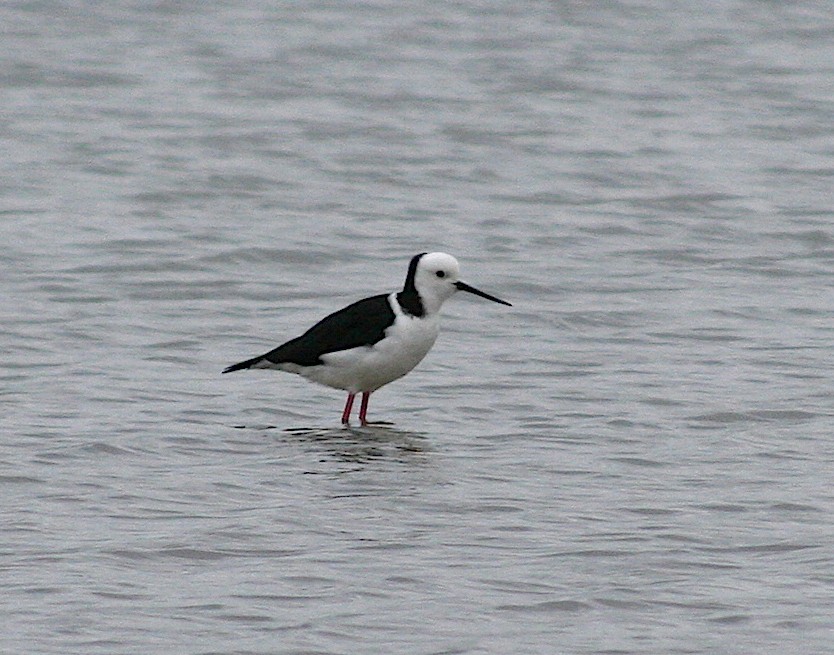Pied Stilt
A species of Stilts, Also known as Australasian Black-winged Stilt, New Zealand Pied Stilt Scientific name : Himantopus leucocephalus Genus : Stilts
Pied Stilt, A species of Stilts
Also known as:
Australasian Black-winged Stilt, New Zealand Pied Stilt
Botanical name: Himantopus leucocephalus
Genus: Stilts
Content
Description People often ask General Info
Description
The pied stilt grows to a length of about 14 in (36 cm) with a wingspan of about 26.5 in (67 cm). The back of the head and neck, the back and the upper surfaces of the wings are glossy greenish-black. The undersides of the wings are plain black and the remainder of the plumage is white, apart from the tail feathers which are tinged with grey. The long, thin legs are pink and the toes have black claws. The long slender beak is black and the irises and the eyelids are red. 
Size
40 cm
Nest Placement
Ground
Feeding Habits
Pied Stilt consumes a carnivorous diet focusing on aquatic invertebrates and vertebrates, as well as occasional seeds. Main food sources include various insects, mollusks, crustaceans, worms, tadpoles, and small fish. Feeding behaviors involve visual and tactile methods, adapting to seasonal changes. Males may feed in slightly deeper waters, while typically favoring shallower environments.
Habitat
Pied Stilt typically inhabits shallow wetlands across broad geographical regions, including Oceania and parts of Southeast Asia. Preferring freshwater environments, they are found in marshes, swamps, lake edges, riverbeds, and floodplains, as well as man-made habitats like sewage ponds. They also frequent saline environments such as salt pans and coastal saltmarshes. During breeding, pied Stilt often nests on islets within these habitats. Outside the breeding season, they congregate in estuarine coastal areas and large inland water bodies.
Dite type
Carnivorous
People often ask
General Info
Feeding Habits
Bird food type
Behavior
The pied stilt is a waterbird and feeds in shallow water, probing into the sediment with its beak. It is gregarious, and in New Zealand sometimes forms mixed flocks with the black stilt (Himantopus novaezelandiae). It feeds largely on aquatic insects and on small molluscs. It emits a repeated yelping cry as it flies, and the legs trail behind it, tending to sway from side-to-side. The pied stilt breeds in spring, choosing as a nesting site an area of sand or shingle by an estuary, beside a dried up riverbed, on a flat bit of coast or in a grassy field near the sea. It seems particularly attracted to locations near where the red duck-weed (Azolla rubra) flourishes. It prepares a nest in a shallow depression or in a scrape in the ground where it usually lays four, ovoido-conical eggs. These are yellowish-brown dappled irregularly with dark blotches and spots. The nest is difficult to find as the eggs are well-camouflaged. But the parent birds give away the presence of the nest by mounting into the air and flying in circles, uttering distress cries. The chicks are able to leave the nest almost as soon as they have hatched. They are difficult to detect because their downy plumage is well-camouflaged and they "freeze" when alarmed. A parent bird sometimes feigns a leg injury to draw intruders away from its chicks. 
Distribution Area
The pied stilt is resident in southern Sumatra, Java, Sulawesi and most of Australia, New Zealand and Papua New Guinea. There are non-breeding populations in Sri Lanka, the Philippines, Brunei, Palau, South Kalimantan, West Nusa Tenggara, East Nusa Tenggara, East Timor and New Guinea. This bird is a vagrant to Japan and Christmas Island. 
Scientific Classification
Phylum
Chordates Class
Birds Order
Shorebirds Family
Stilts and avocets Genus
Stilts Species
Pied Stilt 